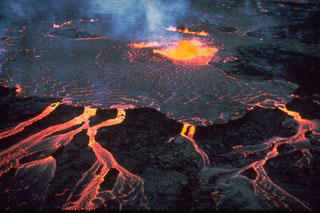Report on Kilauea (United States) — December 1987
Scientific Event Alert Network Bulletin, vol. 12, no. 12 (December 1987)
Managing Editor: Lindsay McClelland.
Kilauea (United States) Lava flows into sea, destroys more houses
Please cite this report as:
Global Volcanism Program, 1987. Report on Kilauea (United States) (McClelland, L., ed.). Scientific Event Alert Network Bulletin, 12:12. Smithsonian Institution. https://doi.org/10.5479/si.GVP.SEAN198712-332010
Kilauea
United States
19.421°N, 155.287°W; summit elev. 1222 m
All times are local (unless otherwise noted)
The . . . eruption continued through December . . . . After the brief hiatus at the end of November, flows re-entered the ocean W of Kupapau Point on 7 December and E of the point the next day. Throughout the month, flows entered the SE part of Royal Gardens, mostly on top of older lava. On 3 December, heat from a finger of lava ignited the last remaining house in the SE part of the subdivision. Another lobe moved slowly along the E margin of the 1986-87 lava field S of the coast highway, entered the ocean on 20 December, and continued intermittently for the rest of the month. The flow overran a beach house on the 28th, and burned another on 12 January.
Glow was seen above the inactive Pu`u `O`o vent on 3 December, but heavy fuming obscured the crater floor until the 9th, when lava was seen ~125-150 m down in the conduit. The crater is ~150 m wide at the top.
Harmonic tremor continued . . . at low to moderate levels . . . near Pu`u `O`o. Sporadic rockfall events recorded at Pu`u `O`o during the month peaked on 18 December between 1413 and 1416, with a series of four moderate-sized collapse events. Typical inflation-related shallow microearthquakes in the summit region averaged ~100/day with a peak of ~300 daily for several days during the middle of the month. A swarm of very small, shallow, long-period events accompanied by weak tremor persisted beneath the summit caldera 3-20 December. Most of the month's strong earthquakes occurred . . . beneath the S flanks of Kīlauea and Mauna Loa. Ten were of M 3.0-4.2.
Geological Summary. Kilauea overlaps the E flank of the massive Mauna Loa shield volcano in the island of Hawaii. Eruptions are prominent in Polynesian legends; written documentation since 1820 records frequent summit and flank lava flow eruptions interspersed with periods of long-term lava lake activity at Halemaumau crater in the summit caldera until 1924. The 3 x 5 km caldera was formed in several stages about 1,500 years ago and during the 18th century; eruptions have also originated from the lengthy East and Southwest rift zones, which extend to the ocean in both directions. About 90% of the surface of the basaltic shield volcano is formed of lava flows less than about 1,100 years old; 70% of the surface is younger than 600 years. The long-term eruption from the East rift zone between 1983 and 2018 produced lava flows covering more than 100 km2, destroyed hundreds of houses, and added new coastline.
Information Contacts: C. Heliker and R. Koyanagi, HVO.

